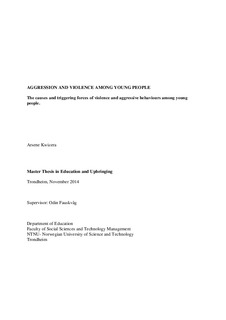Aggression and Violence Among Young People - The causes and triggering forces of violence and aggressive behaviours among young people
Master thesis
Permanent lenke
http://hdl.handle.net/11250/278323Utgivelsesdato
2014Metadata
Vis full innførselSamlinger
Sammendrag
This study will look at what might be the causes and triggering forces that can contribute to the instigation of aggressive behaviours mostly among young people, its expression and manifestation. On a daily basis, we accustomed to turn on our TV for morning news or read a newspaper and learn about an act of violence and aggression towards a follow man or between communities. Aggression has become a natural risk to a level where every area of human condition of existence is characterised by acts of violence, cruelty and destruction. The method that has been used can be referred to the historical method that consists of assembling information through an analysis and reading of different text books and articles.
Participation to one’s own culture can be a basic foundation to define humans, but aggression and destructive behaviour can also be considered as part of man inner being. Man can as well lose his unique individual features as part of a group. Being aggressive might mean standing for his own, his beliefs and being forceful, getting on his own way in his dealings and attempting to solve the problems facing him. The individual might appear unfriendly and even prone to hurt others. Since we also encounter contradictions and ambivalence in our daily and social feelings that are built in infancy, not only a social perspective can also be used to explain aggression but also our wrong assessment and interpretation of the situation or through our interactions with others. As I argue in this thesis, before seeing aggression as an acquired and learned response due to the influence of environmental factors, it is necessary to take into consideration the conception of an innate biological determined instinctual drive. However, some provocation factors must be in place for aggression to manifest itself, repressed feelings also are able to reproduce themselves unconsciously and resurface again into consciousness. This study may not be the final answer to problem of aggression but I believe that it carries with it additional information for educators since it deals with a problem which is of social importance, a problem that has become unstoppable and which affects mainly the youth.
